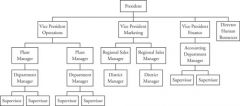![]()
![]()
![]()
Use LEFT and RIGHT arrow keys to navigate between flashcards;
Use UP and DOWN arrow keys to flip the card;
H to show hint;
A reads text to speech;
17 Cards in this Set
- Front
- Back
|
4 Functions of Management? |
Planning, Organizing, Control & leadership |
|
|
Planning Process? |
1. set objectives 2. where are vis a vis objectives 3. forecast future scenarios 4. list alternatives and choose best 5.implement/evaluate |
|
|
Control Process? |
1. set objectives 2. measure performance 3. compare goal to your performance 4. take action if needed |
|
|
5 steps of decision making? |
1. Define the problem 2. Alt. solutions 3. Make a decision 4. implement 5. how did the decision work out
|
|
|
3 Functions of human resources? |
1. attracting the workforce 2. develop the workforce 3. maintain the workforce |
|

|
Functional Structure Advantage: Econ of Scale Disadvantage: communication with other departments |
|
|
5 Sources of Power? |
1. legitimate (I'm the boss) 2. Coersive ( punishment) 3. Reward 4. expert power(respect your knowledge) 5. Referent Power(to please boss)
|
|
|
5 Principles of Visionary Leadership? |
1. Challenge the process 2. Show Enthusiasm 3.help others to act 4. set the example 5. celebrate achievements |
|
|
5 core characteristics of jobs? |
1. skill variety 2. task identity 3. task significance 4.Autonomy 5. Feedback |
|

ERG Theory |
Existence Relatedness Growth |
|
|
Two factor Theory? |
Hygiene Motivator |
|
|
Expectancy Theory |
Expectancy x Instrumentality x Valence |
|
|
Reinforcement Theory |
positive, negative, punishment, extinction |
|
|
Job Performance |
Ability x Support x Effort |
|
|
5 Main Personality Traits |
Extroversion Agreeableness conscientiousness Emotional Stability Openness |
|
|
Conflict management styles |
Avoidance Accomodate Competition Compermise Collaborate
|
|
|
Communication Barriers |
Poor written/ Oral expression Failure to Recognize "Non Verbal Signs" Physical Distractions Status Effects |

